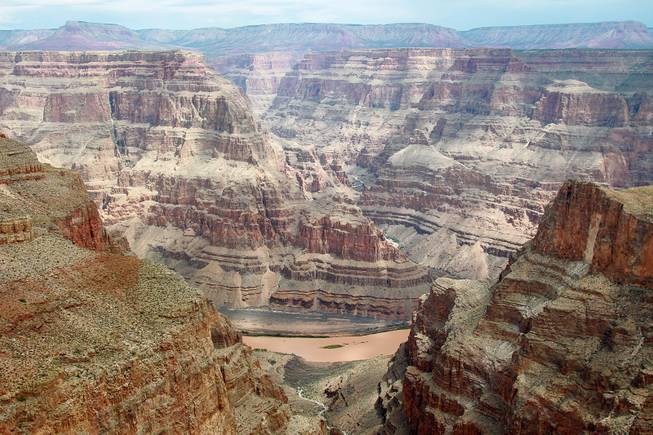Monday, June 19, 2017 | 2 a.m.
In 2012, then-President Barack Obama issued a 20-year ban on mining claims near the Grand Canyon. The move halted future uranium extraction projects in the region, a win for environmentalists and local tribes that had fought against the industry for years. But some elected officials in Arizona and Utah disputed their claims of contamination risk, arguing that the ban would unnecessarily sacrifice jobs for overblown environmental concerns.
With President Donald Trump swinging the pendulum toward economic development, opponents of the ban are asking the administration to lift it.
Their request and Trump’s reconsideration of nuclear policy in the West have stoked debate over how environmental concerns should be weighed against economic potential. That tension underlies discussions about everything from increasing nuclear testing to storing nuclear waste in Yucca Mountain, only 90 miles from Las Vegas. And it highlights the inescapable nature of the West’s nuclear legacy.
Nonprofit magazine High Country News put it this way in a recent story: “When you’re dealing with elements … that take billions of years to decay, the past is never really past.”
Andrew Kirk, a history professor at UNLV, studies the relationship between Western states and the federal government’s nuclear activities going back to the Manhattan Project. Kirk, who recently wrote “Doom Towns,” a graphic history on atomic testing, said that Westerners had often felt “conflicted” about nuclear activities, especially as people became more aware of the effects of radiation. At the same time, federal funding for nuclear activities helped stimulate the economy.
“The federal government built the American West, and atomic developments greatly enhanced that relationship between region and nation,” Kirk wrote in an email. “Westerners have a love-hate relationship with the federal government. They know they gain much by hosting critically important programs but always do so with a loss of power and control over an environment they love.”
In March, the Trump administration drew the ire of many Nevada officials when it proposed to revive plans for a nuclear waste repository at Yucca Mountain. Heavyweights from both parties, ranging from Republican Gov. Brian Sandoval to Democratic U.S. Rep. Dina Titus, have long opposed the plan. They worry about safety and the environment — about seismic activity at the mountain and nuclear waste seeping into the water table.
They also offer an economic argument. They worry that siting a nuclear waste dump near Las Vegas could hurt tourism, the lifeblood of the region. But others disagree with the consensus among Nevada politicians. Nye County, where the project would be sited, hasn’t taken a position on the project. The chairman of the county commission, Dan Schinhofen, remains neutral, arguing that science should dictate whether the project moves forward. Though the state and federal governments have studied Yucca, often reaching different conclusions but both noting some inherent risk, he says the concerns might be exaggerated. And he argues that there are economic benefits for the county.
“While many in the West embrace and celebrate the region’s role in atomic history, there is also widespread concern that atomic activities caused significant environmental and human health issues,” Kirk said of the recent developments in the budget. “Many still chafe at the ‘wasteland’ designation and will never support a resumption of the level of activity that occurred during WWII and the Cold War, despite the economic benefits that might come with the deal.”
According to Kirk, during nuclear site-selection trips to parts of Nevada, Arizona and Mexico, government officials described the areas as ‘empty,’ ‘unpopulated,’ worthless,’ and ‘wastelands.’
“These assumptions explain much about where nuclear activities were located and how the new experimental landscapes and the people who lived throughout them were treated,” Kirk said.
And they continue to loom over discussions today. In Arizona, environmentalists and tribes are concerned about future uranium mining because of past contamination. They worry that it could damage sacred land or contaminate groundwater and streams that feed into the Colorado River.
“We’ve seen some problems associated with mining, historically,” said Sandy Bahr, the Sierra Club’s chapter director for the Grand Canyon region. “More recently, mines that were not covered by the withdrawal have had contamination issues — air and water issues.”
Buster Johnson sits on the Mohave County Board of Supervisors, the political body in Arizona asking the Trump administration to reconsider the uranium moratorium. Johnson concedes that lax oversight in the ’40s and ’50s led to contamination. But he said today’s regulations would prevent that kind of pollution from occurring. “I don’t think we’re solving any problems by not removing it. There are monetary benefits to everybody. We have stringent regulations here in the U.S.,” he said.
The Sierra Club and other environmental groups disagree with his assessment.
In 2010, the U.S. Geological Survey released a report on uranium contamination in the area. Environmentalists and the mining industry highlighted data to prove their respective sides of the argument. The study found high uranium concentrations in 20 springs and wells but said they could have been the result of natural contamination. Opponents highlighted uranium concentrations — about 10 times the natural level — in water near a mine that operated under old environmental standards. The USGS report said of this partially mined site: “Mined waste rock, uranium ore, pond sludge and local wind and water dispersed fine particles on the unreclaimed mine site … (that) were exposed to the ambient environment for about 20 years.”


Join the Discussion:
Check this out for a full explanation of our conversion to the LiveFyre commenting system and instructions on how to sign up for an account.
Full comments policy